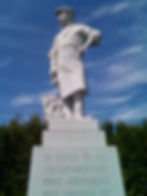Down the Research Rabbit Hole
- cherylaossola
- Sep 8, 2020
- 2 min read

The genealogy research rabbit hole, to be precise. I have four lines of Italian ancestors to continue discovering, and the one that has captivated me most is my father's paternal line, because I know the least about them. I do this work in spurts because once I start I get obsessed and all else falls by the wayside.
This time, devoting an entire Sunday to online research paid off. I made some super-important (to me) discoveries, the most significant of which is what happened to my paternal bisnonno (great-grandfather), who had emigrated from the tiny town of Viggiù before the turn of the 20th century.
My father's ancestors lived in Barre, Vermont, where my dad grew up. Many of them were stonecutters who worked in the granite sheds there—the city is known worldwide for its granite, called Barre Gray, a beautiful, rich stone flecked with mica. Thousands of Italians from the Varese province of Lombardia, my father's family among them, immigrated to Barre around the turn of the 20th century, when the granite industry took off. (The full inscription on the statue above: "In honor of all Italian-Americans whose achievements have enriched the social, cultural and civic vitality of this city, region and state." Then: "Erected by their descendants and friends. Dedicated to Carlo Abate, artist, mentor, and friend. Born Milano Italia 1860–died Barre VT 1941.")

I had tracked my bisnonno until 1910, at which point he disappeared from census records and city directories. I didn't find him anywhere else in the U.S., nor on any ship manifests. Turns out he did sail on one of those ships, though—he went back to Viggiù in 1912 for an extended visit and died there four years later. After years of searching, I'm thrilled to know I can probably find his grave. (Major research trip to come, to all the hometowns of my father's side of the family—Viggiù, Cantello, Arcisate, Brenno Useria, Besano, and Gallarate.)
As a result of all this exploration, I've decided to rewrite my first (unpublished) novel, which tells the story of an Italian immigrant family of stonecutters in Barre, Vermont, in the politically charged years of the early 20th century. Major, major changes, and all for the good. The story is fiction, but inspired, obviously, by my family's history. It's a story I've wanted desperately to tell, but I hadn't found the right way into it. Now I have.
I'd started another novel, set here in Perugia, but the delay will do it good; it needs some simmering time and lots more research. Right now my brain is occupied with Italian immigrants and stonecutters and mal d'america (what the Italians called the particularly virulent form of silicosis that killed many stonecutters, many of them young) in the socialist hotbed of Barre, Vermont, where the likes of Emma Goldman and Eugene Debs mesmerized crowds and created chaos. In their own way, the stonecutters fighting for workplace rights were engaging in, by the late Rep. John Lewis' definition, "good trouble, necessary trouble." What I can do, all these years later, is amplify their voices.